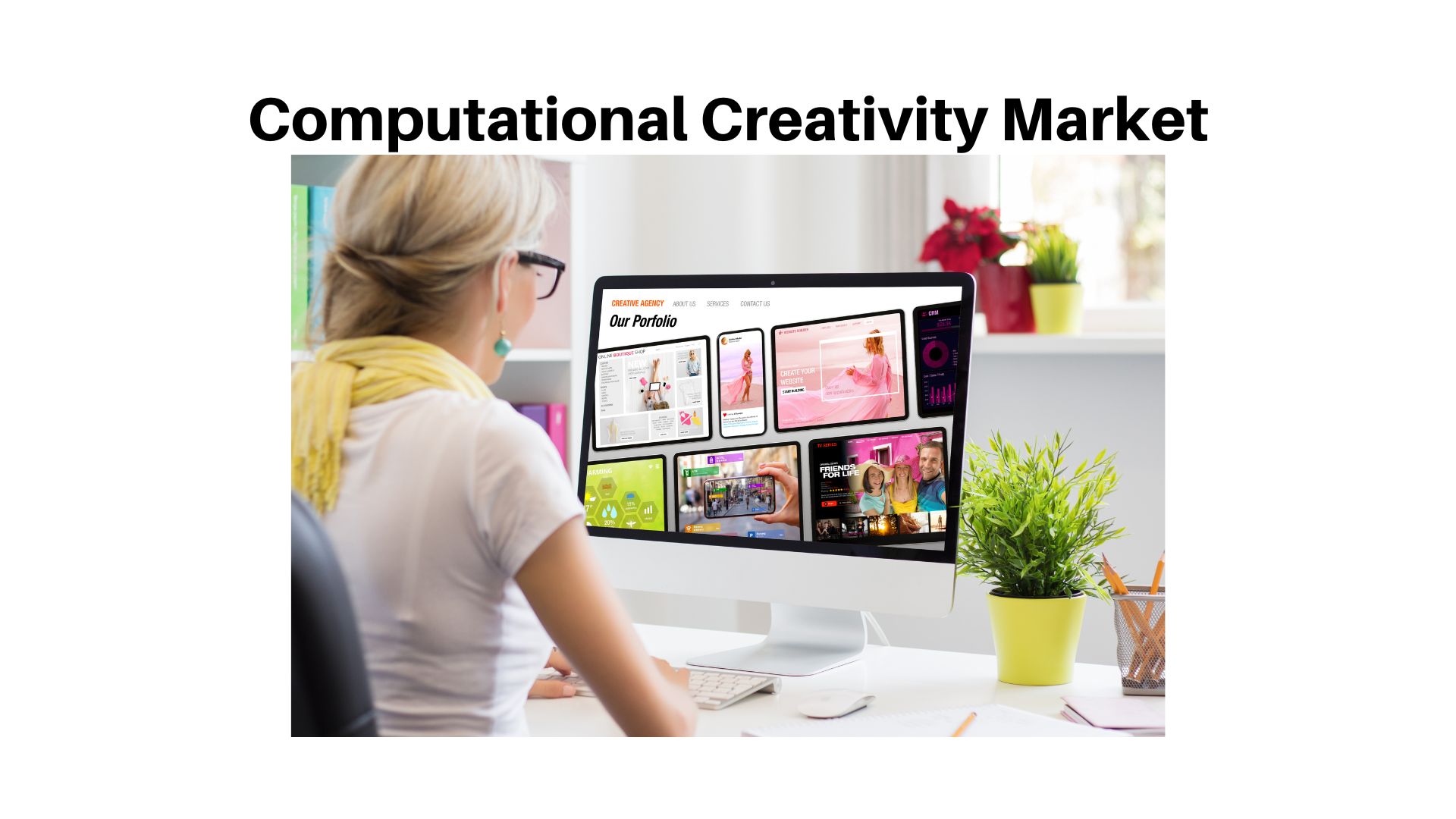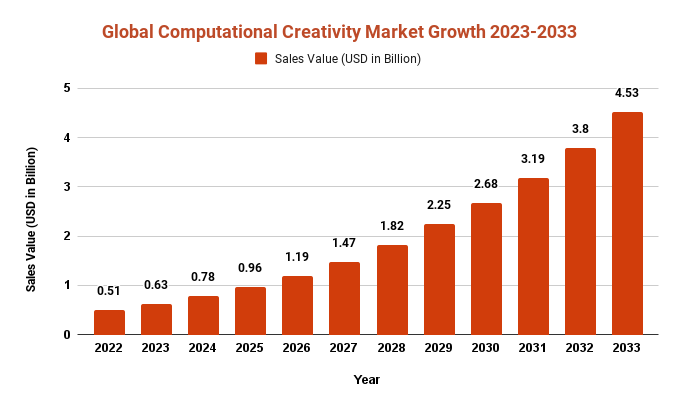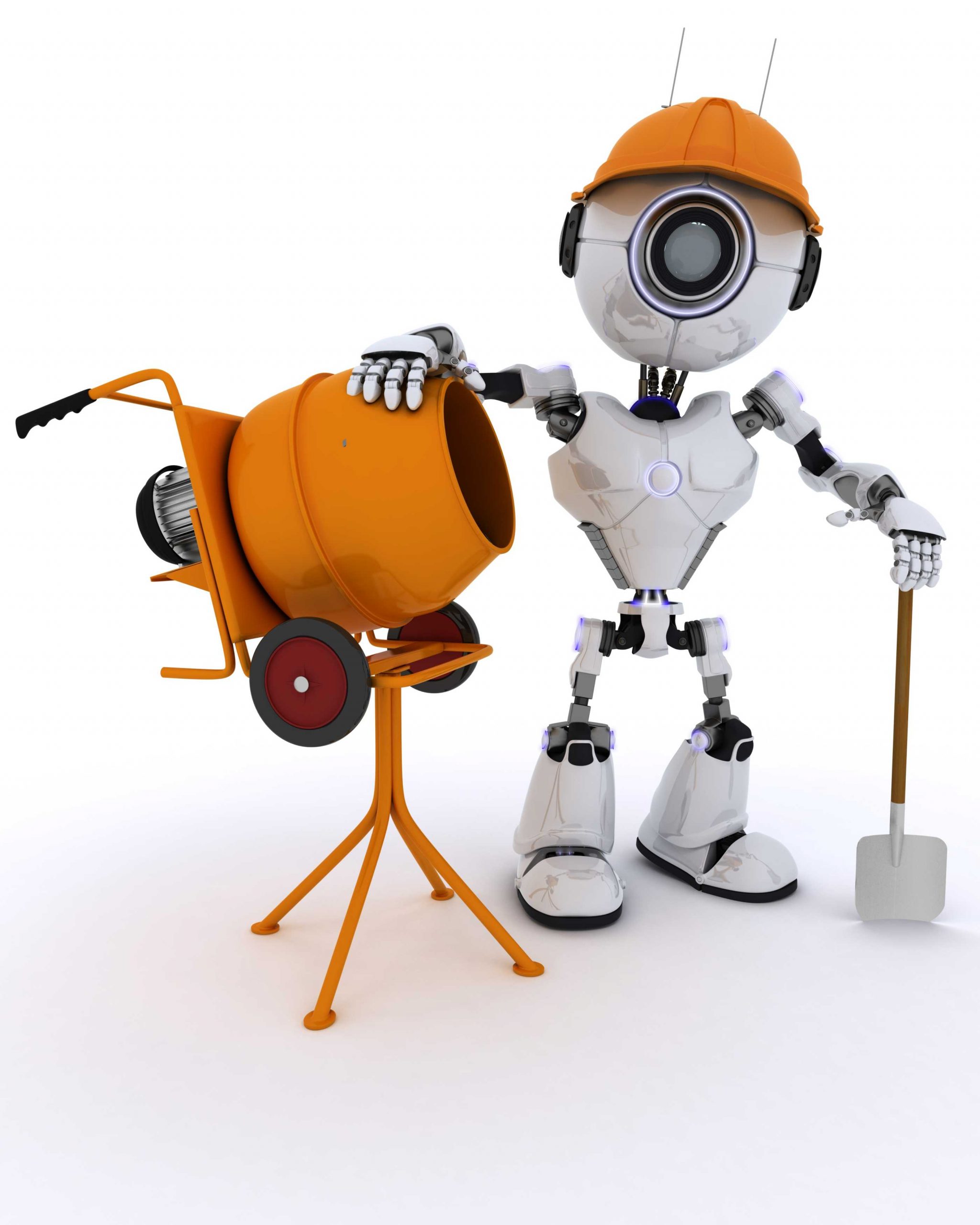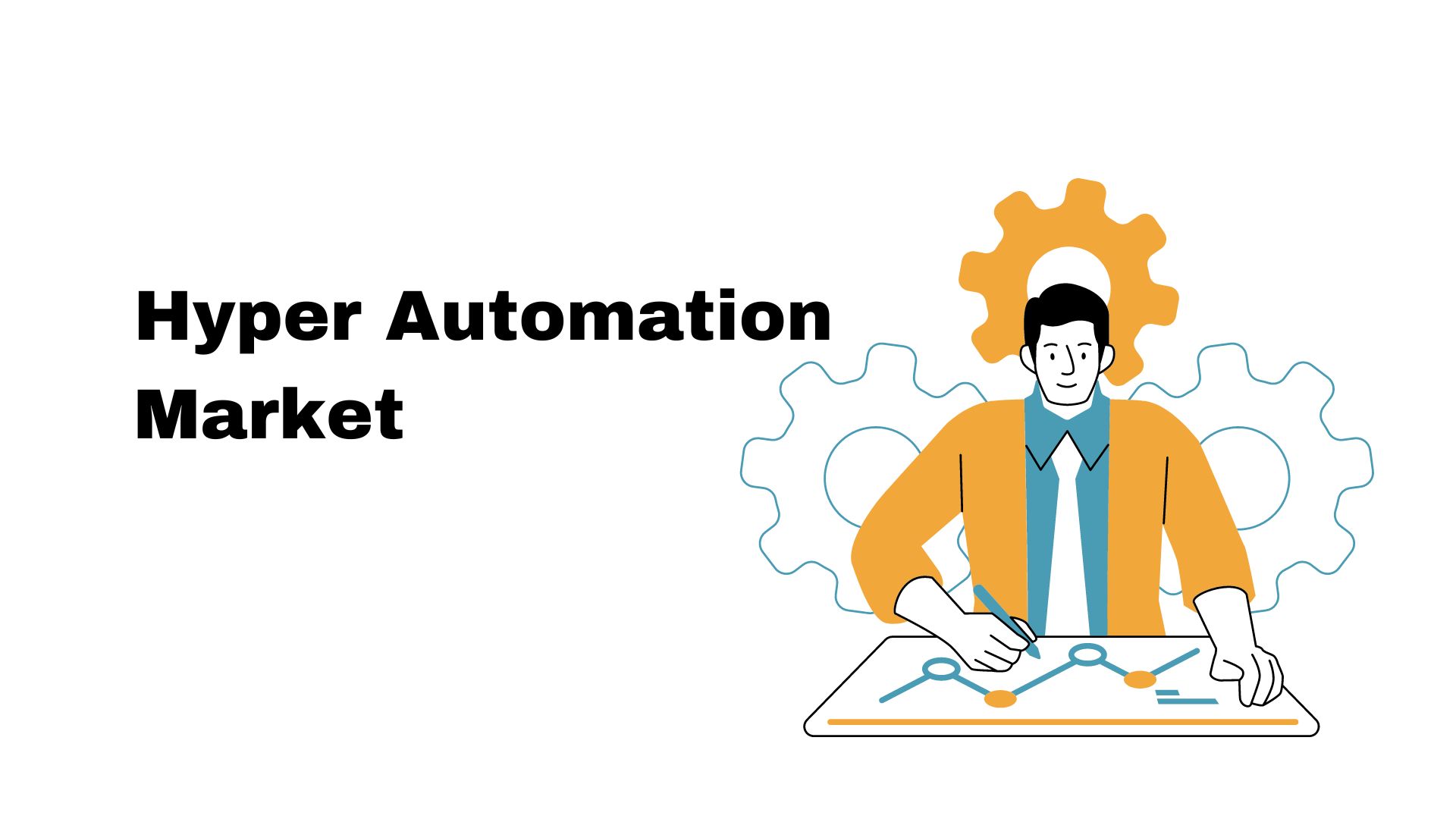Computational Creativity Market size is expected to reach USD 4.53 Bn by 2033

Page Contents
Market Overview
Published Via 11Press: Computational creativity Market is a field within Artificial Intelligence (AI) and cognitive science that studies computer systems capable of producing creative outputs or behaviors, mimicking human processes for creating novel and useful ideas, products or solutions. Computational creativity seeks to understand and replicate human creativity by developing computer programs capable of mimicking these processes. It aims to mimic what makes humans creative.
The Computational Creativity Market size is expected to reach USD 4.53 Bn by 2033, up from its current value of USD 0.51 Bn in 2022, growing at an annual compound growth rate (CAGR) of 19.12% from 2023-2033.
Computational creativity research incorporates ideas and techniques from different fields, such as AI, cognitive psychology, philosophy, linguistics, and neuroscience. Researchers in this area use computational methods to model and simulate creative cognitive processes such as idea generation, problem-solving, imagination etc.
- Generative Systems: Generative systems use algorithms to produce unique ideas, designs, or artworks.
- Collaborative Systems: These systems collaborate with humans to jointly or co-create creative outputs.
- Evaluative Systems: These systems employ computational models to assess the creativity of human-created or machine-generated outputs.
- Adaptive systems: These adaptive systems can learn and adjust to meet a user's personal preferences, style or creative goals.
Applications of computational creativity range from art and music generation, game design, storytelling, advertising, product design and scientific discovery. Key challenges and ethical concerns associated with computational creativity include evaluation and interpretation of creativity; striking a balance between novelty and familiarity; accounting for human judgment biases and impacts; as well as potential negative repercussions for human creativity and labor.
Key Takeaways
- Computational creativity is a field that specializes in artificial intelligence (AI) and cognitive science that involves the design of computer systems capable of producing creative outputs or behaviors.
- Computing creativity systems can be divided into generative, collaborative, evaluative and adaptive categories.
- Computational creativity research integrates techniques from various disciplines, including AI, cognitive psychology, philosophy, linguistics, and neuroscience.
- Computational creativity has many applications in art and music creation, game design, storytelling, advertising campaigns, product design and scientific discovery.
- Challenges and ethical concerns associated with this field include the evaluation and interpretation of creativity, striking a balance between novelty and familiarity, understanding human judgment biases and potential impacts on human creativity and labor.
- Computational creativity systems can be evaluated on various criteria, such as originality, usefulness, novelty, and surprise.
- Computational creativity systems are capable of working independently or alongside humans in order to generate creative outputs.
- Computational creativity serves as an adjunct to human creativity, offering new tools and methods to support and foster creative processes.

Request Sample Copy of Computational Creativity Market Report at: https://marketresearch.biz/report/computational-creativity-market/request-sample/
Regional Snapshot
North America: North America has long been considered an epicenter for research and development on computational creativity, with numerous universities and research institutions leading the charge in this area. Google, Microsoft and Adobe are key players in North America that have developed computational creativity tools and applications. Furthermore, North America boasts numerous startups focused on art/music/game/advertising creation as well as game design/advertising design/advertising/marketing etc. (Nature 457; 2012).
Europe: Europe boasts an enduring artistic heritage that has translated to computational creativity research and innovation. To this end, the European Union has invested in several research projects dedicated to computational creativity such as CREAM and COINVENT.
Key players in this region include the Universities of Edinburgh, London and Helsinki.
Asia: Asia has witnessed tremendous expansion of computational creativity research and innovation over recent years with many universities and research institutions making significant investments into this field. China has emerged as a powerhouse in computational creativity research and development, with companies like Baidu and Alibaba making considerable investments into computational creativity research and development. Japan boasts a longstanding culture of creativity and art, which has resulted in several computational creativity applications like music and game generation software.
Latin America: Latin America has seen an increased interest in computational creativity research and innovation from academic institutions as well as research institutes, with numerous universities investing in this field. Central players in Latin America include the Federal University of Rio Grande do Sul in Brazil and Pontifical Catholic University of Peru as key institutions. Latin America boasts a dynamic startup ecosystem focused on creative industries that could benefit from computational creativity tools and applications.
Africa: Africa remains in its early stages of computational creativity research and development, with only a select few universities and research institutions investing heavily in this area. AIMS recently initiated a program on computational creativity as part of its efforts to promote research and innovation within this field. There is an increasing interest in using computational creativity for cultural preservation and heritage conservation, particularly in regions with diverse traditions like Egypt and South Africa.
Any inquiry, Speak to our expert at: https://marketresearch.biz/report/computational-creativity-market/#inquiry
Drivers
Recent Advancements in Artificial Intelligence (AI) and Machine Learning (ML): AI and ML technologies have enabled powerful algorithms and tools that mimic human creative processes, enabling computational creativity systems to generate novel ideas and solutions with greater ease than ever before.
- Data availability: With more and more images, audio files, text documents and digital media files being freely accessible online, computational creativity systems now have access to an unprecedented source of inspiration and reference material for creating new ideas and outputs.
- Creativity Industry Trends: Creative industries such as art, music, film and advertising are becoming more critical drivers of economic growth and innovation. Computational creativity systems offer new tools and methods that support human creative processes in these industries.
- Cultural Preservation and Heritage: Computational creativity can play a pivotal role in protecting and promoting cultural heritage such as language, music, art and literature. This helps preserve cultural diversity as well as foster intercultural understanding and exchange between groups of people.
- User-Generated Content: User-generated content such as social media posts, blogs and online reviews has quickly become an invaluable source of inspiration and reference for computational creativity systems. These systems can analyze and synthesize user-Generated content to generate new ideas and outputs.
- Collaborative and Participatory Creativity: Computational creativity systems can work collaboratively with humans to generate creative outputs, which may open up new forms of participatory creativity where individuals or communities can co-create and share creative outputs.
- Education and Research: Computational creativity has an integral place in education and research by offering new tools and methodologies for teaching creative skills to children, and by expanding our understanding of human creativity and cognitive processes.
Restraints
- Limited understanding of creativity: Creativity is a complex and multidimensional construct that is difficult to fully comprehend. There is no universal definition or standard for measuring it across cultures or disciplines, which presents computational creativity systems with unique challenges when they rely on human judgments and evaluations of creativity as their measuring stick.
- Ethics and Bias: Computational creativity systems may perpetuate human biases and stereotypes, leading to negative social and cultural impacts. There is the risk that these systems will produce offensive, harmful, or misleading outputs which could damage reputations or cause physical harm to individuals or communities.
- Lack of Transparency and Interpretability: Computational creativity systems may be difficult to interpret due to their reliance on complex algorithms and machine learning models, creating challenges in understanding how these systems generate their outputs, as well as assessing their quality and originality.
- Computational creativity systems often struggle to generate creative outputs that are relevant and appropriate for certain domains and contexts, such as cultural, linguistic, or historical environments. Such outputs could include offensive material that fails to capture the subtleties and intricacies of various creative domains.
- Intellectual Property and Ownership: Computational creativity systems raise complex legal and ethical considerations surrounding intellectual property and ownership of creative outputs. For instance, these systems may infringe existing copyright or patent laws, or produce outputs which resemble existing creative works and therefore cause doubt about originality and ownership of creative works generated from them.
- Cost and Access: Establishing computational creativity systems can be both time- and cost-consuming, restricting their availability to smaller organizations and individuals. Data and computing resources may also limit development and deployment efforts of such systems.
- Impact on Human Creativity and Labor: There is some concern that computational creativity systems might replace or undermine human creativity and labor by automating creative tasks that appear human-made, producing outputs which cannot be distinguished from what a person would produce – potentially having significant social, economic, and psychological ramifications both individually as well as society at large.
Opportunities
- Enhancing human creativity: Computational creativity can support and amplify human creativity by offering new tools and methods for creating, evaluating, and refining creative outputs. This allows individuals and organizations to generate innovative new ideas, products, or services more rapidly and successfully than before.
- Computational creativity systems can aid individuals and organizations alike in making more effective decisions by offering an array of creative solutions and alternatives for consideration, which may lead to improved outcomes and higher levels of innovation across various disciplines such as business, engineering, and social sciences.
- Personalization and customization: Computational creativity can provide customized outputs tailored specifically to individual needs and preferences, for instance by producing music, art or fashion that reflects user preferences and characteristics. For instance, computational creativity systems could generate personalized music videos or artworks according to user characteristics or tastes.
- Social and Cultural Impact: Computational creativity can have an enormously positive effect on society and culture by encouraging diversity, intercultural exchange, social inclusion, preservation of cultural heritage as well as supporting new forms of participative creativity that involve individuals and communities alike.
- Computational creativity can significantly advance scientific research by providing new tools and methodologies for modeling and simulating complex systems and processes, including those involved with human creativity and cognitive function. Computational creativity may even help model these brain processes that facilitate such creativity.
- Computational creativity has the power to open up new business opportunities by helping to develop innovative products and services that meet consumer demands, like developing engaging forms of entertainment, advertising, or marketing that offer better consumer engagement. For instance, computational creativity may provide new means of entertainment delivery or make advertising and promotion more interactive for their target market.
- Education and Learning: Computational creativity can enrich education and learning by providing new tools and methods for teaching creative skills to both teachers and learners alike. For instance, computational creativity may help facilitate interactive and immersive learning experiences which engage students while stimulating creativity and innovation capabilities in students.
Challenges
- Problem of understanding creativity: Creativity is an inexact concept with multiple layers, yet no consensus has been reached as to its definition or characteristics. This poses a difficulty for computational creativity systems that rely on human judgment and evaluation of creativity for evaluation purposes.
- Limitations in Data Access: Computational creativity systems rely on large amounts of high-quality data in order to learn and generate creative outputs, but in certain domains such as fine arts and humanities this data may be scarce or of poor quality, making it challenging for computational creativity systems to produce high-quality outputs.
- Bias and Ethics: Computational creativity systems may reinforce human biases and stereotypes, which may have negative social and cultural ramifications. There is also the risk that computational creativity systems could produce offensive, harmful or misleading outputs which damage reputations or cause physical or emotional harm to individuals or communities.
- Interpretability and Transparency: Computational creativity systems may be difficult to comprehend due to their reliance on complex algorithms and machine learning models, creating difficulties when trying to understand how these systems produce outputs while assessing quality/originality/thenicity of these works.
- Contextual Specificity: Computational creativity systems may struggle to generate creative outputs that are appropriate and relevant to certain domains and contexts, such as cultural, linguistic or historical ones. They could potentially generate outputs which are offensive or inappropriate; or fail to capture nuances and subtleties across creative domains.
- Intellectual Property and Ownership: Computational creativity systems may present complex legal and ethical considerations regarding intellectual property and ownership of creative outputs. There is the risk that such systems could violate copyright or patent laws, or produce works similar to existing creative works that raise questions regarding originality and ownership.
- Cost and Accessibility: Constructing computational creativity systems is both costly and time-consuming, restricting their reach among smaller organizations or individuals. Data or computing resources may limit development or deployment.
Market Segmentation
End User
- Marketing and Web Designing
- Product Designing
- Music Composition
- Photography and Videography
- Automated Story Generation
Operating system
- Linux
- macOS
- Microsoft Windows
deployment
- On-Premises
- Cloud-Based
Key Players
- IBM
- Microsoft
- Prisma Labs Inc.
- Runway AI Inc.
- WaveAI Inc.
- Adobe
- Amazon Inc.
- Autodesk Inc.
- Canva
- Google LLC
Report Scope
| Report Attribute | Details |
| Market size value in 2022 | USD 0.51 Bn |
| Revenue forecast by 2033 | USD 4.53 Bn |
| Growth Rate | CAGR Of 19.12% |
| Regions Covered | North America, Europe, Asia Pacific, Latin America, and Middle East & Africa, and Rest of the World |
| Historical Years | 2017-2022 |
| Base Year | 2022 |
| Estimated Year | 2023 |
| Short-Term Projection Year | 2028 |
| Long-Term Projected Year | 2033 |
Request Customization Of The Report: https://marketresearch.biz/report/computational-creativity-market/#request-for-customization
Recent Developments
- GPT-3 (Generative Pre-trained Transformer 3) was unveiled by OpenAI in 2020 as an innovative language model capable of producing highly coherent and creative natural language text. GPT-3 represents an unprecedented leap forward for computational creativity, being utilized by poets, story writers and other forms of creative writers alike to produce poetry, stories and other creative forms of writing.
- Neural Style Transfer: Neural style transfer is an innovative technique used to generate new artistic styles by applying one image's style onto another. Recent advances have led to more sophisticated algorithms that produce highly realistic and appealing images.
- Creative AI Platforms: Many companies and organizations have developed creative AI platforms that enable users to generate artistic outputs such as music, art, or literature using machine learning or other AI techniques. These platforms are tailored for a broad user base and often used within educational or creative settings.
- Computational creativity and gaming: Computational creativity has become increasingly prevalent in video game development, enabling game designers to generate new characters, levels and quests using machine learning or other artificial intelligence (AI) techniques. This could revolutionize the gaming industry while creating more engaging gaming experiences for gamers.
- Computational Creativity and Music: Computational creativity is being used to generate new forms of music, including generative and interactive styles. Machine learning algorithms create music personalized for each user – providing new forms of expression and musical engagement.
- Computational Creativity and Design: Computational creativity is increasingly being utilized within the field of design, enabling designers to generate innovative new designs through machine learning and other AI techniques. This has the potential to revolutionize this area and open up entirely new avenues of product design innovation.
- Creative Adversarial Networks: These recent advances in computational creativity enable the production of realistic and visually appealing images or other creative outputs using machine learning algorithms. Furthermore, these systems also create innovative designs and styles, providing new avenues for artistic expression and invention.
Key Questions
- What is Computational Creativity?
Computational creativity involves using computer algorithms and machine learning techniques to generate new forms of creative expression – such as music, art, literature or design – using computers as creative agents. - How Does Computational Creativity Work?
Computational creativity works by using algorithms and machine learning models to generate novel and creative outputs by following patterns found within large datasets, while being trained with user-specified parameters and criteria to create unique, creative, and original solutions. - What Are Some Applications of Computational Creativity?
mes Computational creativity has applications in numerous areas, such as music, art, literature, design, gaming and education. It can help generate new forms of creative expression such as generative music composition, interactive art installations or personalized content for individual users. - What are some challenges of computational creativity?
Some challenges associated with computational creativity include an incomplete understanding of creativity, limited data availability, bias and ethics concerns, interpretability and transparency issues, contextual specificity requirements, intellectual property/ownership considerations as well as cost and accessibility considerations. - What are some recent advances in computational creativity?
Recent developments include the release of GPT-3, advances in neural style transfer technology, development of creative AI platforms, use of computational creativity for gaming and music composition and the emergence of creative adversarial networks.
Contact us
Contact Person: Mr. Lawrence John
Marketresearch.Biz (Powered By Prudour Pvt. Ltd.)
Tel: +1 (347) 796-4335
Send Email: [email protected]
The team behind market.us, marketresearch.biz, market.biz and more. Our purpose is to keep our customers ahead of the game with regard to the markets. They may fluctuate up or down, but we will help you to stay ahead of the curve in these market fluctuations. Our consistent growth and ability to deliver in-depth analyses and market insight has engaged genuine market players. They have faith in us to offer the data and information they require to make balanced and decisive marketing decisions.



